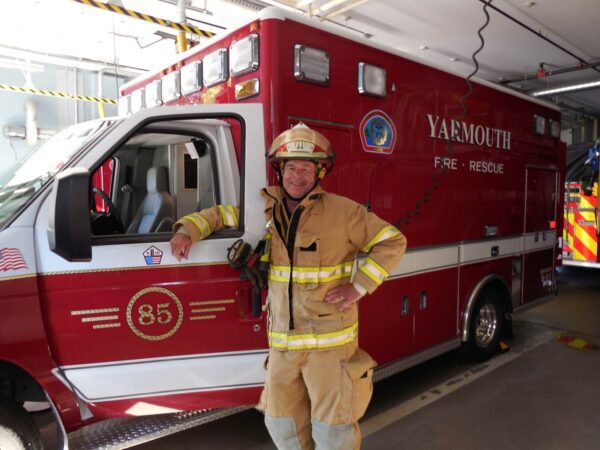
Thomas Downing, Esq is a personal injury attorney and partner at Hardy Wolf & Downing. In his personal life, he is also Captain Downing at Yarmouth Fire/Rescue- FF1/AEMT (picture below). This article on Motor Vehicle Crash Scene Safety was written by Captain Downing.
You are driving along the interstate when it ahead you see traffic has slowed. What’s going on, you ask yourself. As you proceed, you can see there’s a fire truck and police cars ahead of you are near a vehicle. Ah ha a car crash! Get the cell phone out if you’re already talking on it—right? Wrong!
Motor vehicle crashes pose danger to first responders
As a firefighter/EMT this is a very typical situation that we are involved in. In my experience, responding to motor vehicle crashes on the interstate is the most dangerous task that we perform as a department; even more hazardous than structure fires. Why do I say that? Look at the statistics. During a recent year traffic accidents caused the death of 15 police officers, 5 firefighter/EMS personnel, and believe it or not, 60 towing and recovery operators. Why does this happen?
The “5 D’s” & secondary collisions
The probable reason is what we call the five D’s. Drunk, Drowsy, Drugged, Distracted, and Dumb. We all know what dumb and drunk are. But distracted driving can be as simple as using your cell phone to attempt to photograph a crash scene as you drive by. A major cause of injuries and property damage is what are called “secondary collisions” caused by drivers who are not paying attention as they approach and proceed through crash scenes.
These secondary collisions cause even more personal injury and property damage, and also are more likely to cause a shutdown of the road. If you’ve ever been backed up in a long traffic jam behind a car accident in Maine you need to know that for every one minute that traffic is shut down on a road such as interstate results in four minutes of backup. It typically takes us anywhere from 20 to 40 minutes to clear a scene and reopen the traffic lanes which results in a backlog of well over an hour or more. That’s why you see miles and miles of traffic behind these scenes.
Safety tips for car crash victims, witnesses and passers-by
Our goal is to safely clear the scene as soon as possible including treating and transporting any injured patients and getting vehicles removed from the highway. It’s the “rubberneckers” who cause the greatest problem in achieving this result. The driving public needs to know what you can do why you should do it and how we do what we do and how we do what we do.
The first consideration is to yield the right-of-way and enable emergency vehicles to approach the scene as quickly and safely as possible. Maine has a so-called “Move Over Law” which requires you to pass in a lane adjacent to the lane occupied by emergency vehicles. Also, if you are involved in a crash and are there are no injuries or minor injuries only and the vehicles can be moved, many states have ”Driver Removal” laws which means if you can, move the vehicle out of the travel lanes to keep the road open.
Public safety agencies are working hard to make car crash scenes safe and keep traffic moving. Police, Fire/EMS and towing operators are cooperating in a national traffic incident management program to make responses to crash scenes universal throughout the country and designed to set up the scene to be as safe as possible for those involved in the accident as well as the passing motorist. Therefore your courtesy, patience and understanding are very much appreciated when you are confronted by the aftermath of a motor vehicles crash.
Thank you.
Capt. Tom Downing
Yarmouth Fire/Rescue

